Coursework 1005SSL: Microsoft's Organizational Structure Analysis
VerifiedAdded on 2023/01/10
|7
|1441
|82
Report
AI Summary
This report provides a comprehensive analysis of Microsoft's organizational structure. It begins with an introduction to organizational structures and then delves into Microsoft's specific divisional structure, which groups functions within specific divisions to achieve strategic goals. The report highlights key elements such as work specialization, span of control, and formalization. It then explores the advantages of this structure, including accountability and team working, and discusses disadvantages like potential communication issues and a lack of work division. The report concludes by emphasizing the importance of organizational structure for a company's effective operation, recommending a combination of specialization and other elements for optimal results.
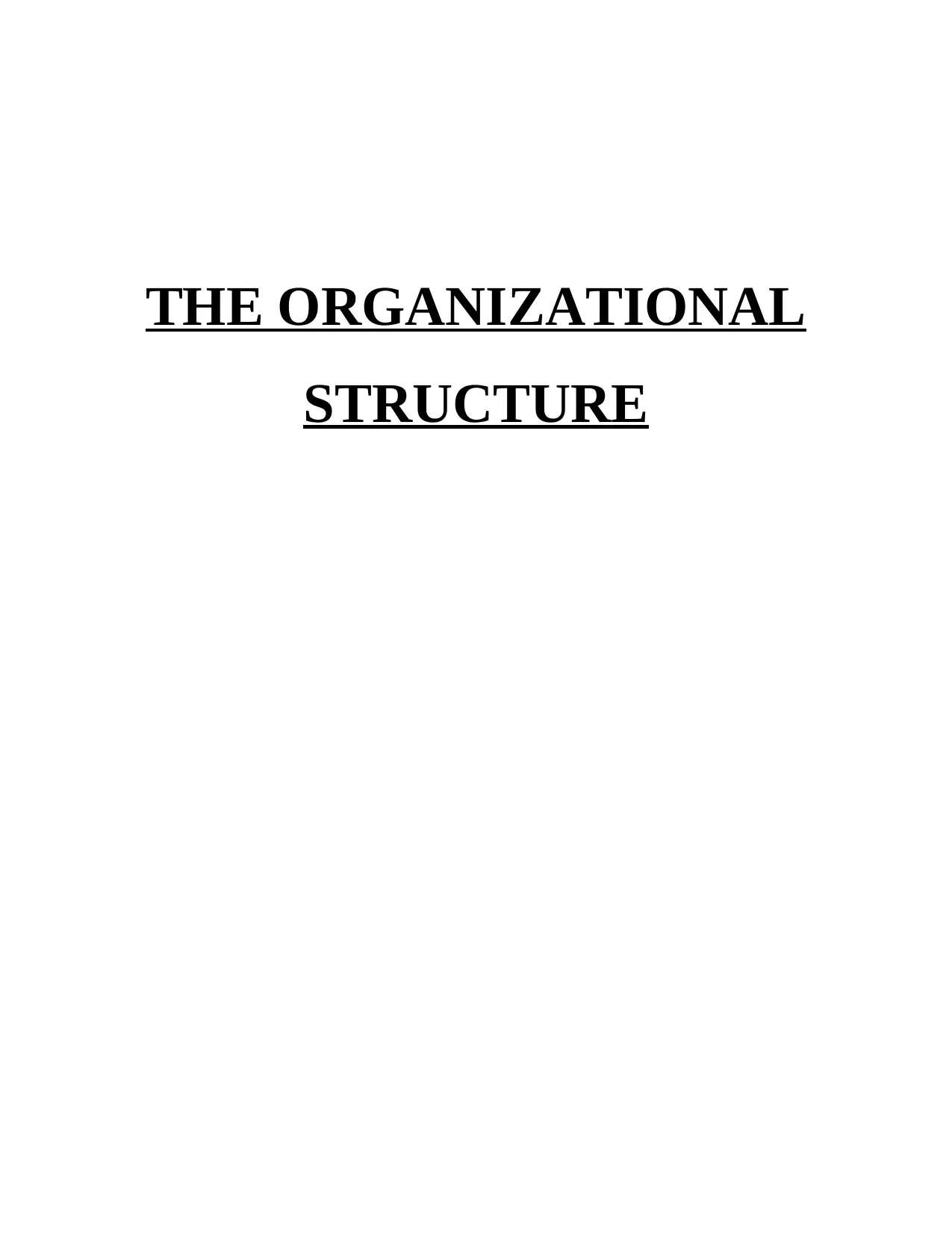
THE ORGANIZATIONAL
STRUCTURE
STRUCTURE
Paraphrase This Document
Need a fresh take? Get an instant paraphrase of this document with our AI Paraphraser
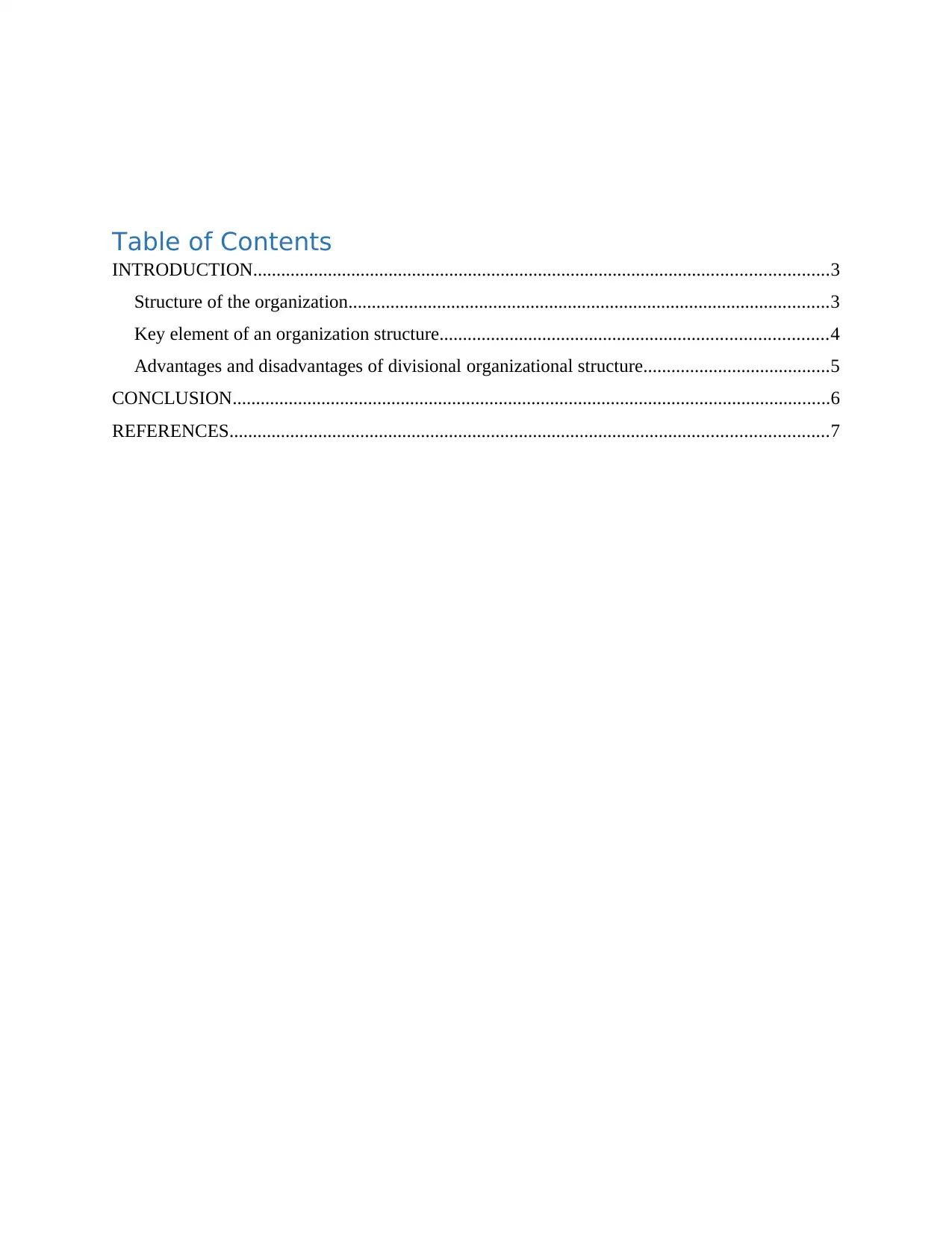
Table of Contents
INTRODUCTION...........................................................................................................................3
Structure of the organization.......................................................................................................3
Key element of an organization structure...................................................................................4
Advantages and disadvantages of divisional organizational structure........................................5
CONCLUSION................................................................................................................................6
REFERENCES................................................................................................................................7
INTRODUCTION...........................................................................................................................3
Structure of the organization.......................................................................................................3
Key element of an organization structure...................................................................................4
Advantages and disadvantages of divisional organizational structure........................................5
CONCLUSION................................................................................................................................6
REFERENCES................................................................................................................................7

INTRODUCTION
An organizational structure is an effective system which helps in effectively outlining
certain set of activities to attain goals of the company. Microsoft is a multinational technological
company which was founded in the year 1975 by Bill Gates and Paul Allen. This company is
also headquartered in Redmond, Washington. The key competitors of the Microsoft company
are Apple, Google, Cisco, SAP, Oracle, IBM, etc. As per 2019, the revenue of the Microsoft
company is 12,580 Crores USD.
Structure of the organization
Microsoft company has a divisional organizational structure. The organizational structure
tends to group each function of the organization within specific divisional group (Bonacchi,
Marra and Zarowin, 2019). Each division tends to effectively handle the specific operational area
to attain strategic goals and objectives. The engineering group of the Microsoft company
includes cloud and artificial intelligence group. The business function is classified into further 9
division which mainly includes business development group, human resource group, corporate
affairs, finance group, marketing group, LinkedIn, worldwide commercial business, corporate
strategy and global operations (Galván and Galván, 2019). The head of the department must in
turn to effectively focus on providing clear set of operational goals associated with the Microsoft
company. This organizational structure helps in providing clear set of view to carry out business
and it also helps in increasing the flexibility of the business. They focus on layering every
department of the organization and eliminating bureaucracy within the organization process.
An organizational structure is an effective system which helps in effectively outlining
certain set of activities to attain goals of the company. Microsoft is a multinational technological
company which was founded in the year 1975 by Bill Gates and Paul Allen. This company is
also headquartered in Redmond, Washington. The key competitors of the Microsoft company
are Apple, Google, Cisco, SAP, Oracle, IBM, etc. As per 2019, the revenue of the Microsoft
company is 12,580 Crores USD.
Structure of the organization
Microsoft company has a divisional organizational structure. The organizational structure
tends to group each function of the organization within specific divisional group (Bonacchi,
Marra and Zarowin, 2019). Each division tends to effectively handle the specific operational area
to attain strategic goals and objectives. The engineering group of the Microsoft company
includes cloud and artificial intelligence group. The business function is classified into further 9
division which mainly includes business development group, human resource group, corporate
affairs, finance group, marketing group, LinkedIn, worldwide commercial business, corporate
strategy and global operations (Galván and Galván, 2019). The head of the department must in
turn to effectively focus on providing clear set of operational goals associated with the Microsoft
company. This organizational structure helps in providing clear set of view to carry out business
and it also helps in increasing the flexibility of the business. They focus on layering every
department of the organization and eliminating bureaucracy within the organization process.
⊘ This is a preview!⊘
Do you want full access?
Subscribe today to unlock all pages.

Trusted by 1+ million students worldwide
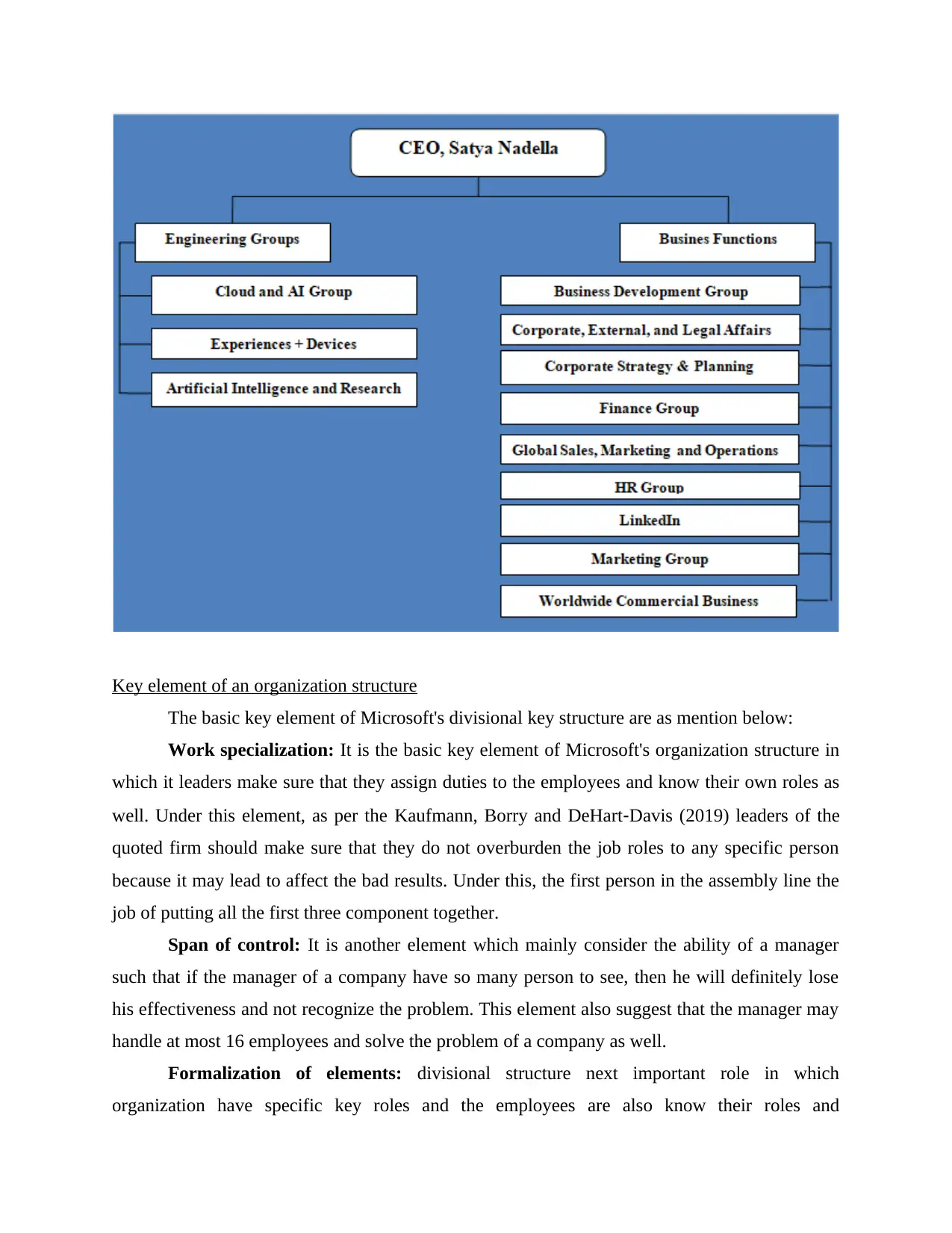
Key element of an organization structure
The basic key element of Microsoft's divisional key structure are as mention below:
Work specialization: It is the basic key element of Microsoft's organization structure in
which it leaders make sure that they assign duties to the employees and know their own roles as
well. Under this element, as per the Kaufmann, Borry and DeHart‐Davis (2019) leaders of the
quoted firm should make sure that they do not overburden the job roles to any specific person
because it may lead to affect the bad results. Under this, the first person in the assembly line the
job of putting all the first three component together.
Span of control: It is another element which mainly consider the ability of a manager
such that if the manager of a company have so many person to see, then he will definitely lose
his effectiveness and not recognize the problem. This element also suggest that the manager may
handle at most 16 employees and solve the problem of a company as well.
Formalization of elements: divisional structure next important role in which
organization have specific key roles and the employees are also know their roles and
The basic key element of Microsoft's divisional key structure are as mention below:
Work specialization: It is the basic key element of Microsoft's organization structure in
which it leaders make sure that they assign duties to the employees and know their own roles as
well. Under this element, as per the Kaufmann, Borry and DeHart‐Davis (2019) leaders of the
quoted firm should make sure that they do not overburden the job roles to any specific person
because it may lead to affect the bad results. Under this, the first person in the assembly line the
job of putting all the first three component together.
Span of control: It is another element which mainly consider the ability of a manager
such that if the manager of a company have so many person to see, then he will definitely lose
his effectiveness and not recognize the problem. This element also suggest that the manager may
handle at most 16 employees and solve the problem of a company as well.
Formalization of elements: divisional structure next important role in which
organization have specific key roles and the employees are also know their roles and
Paraphrase This Document
Need a fresh take? Get an instant paraphrase of this document with our AI Paraphraser
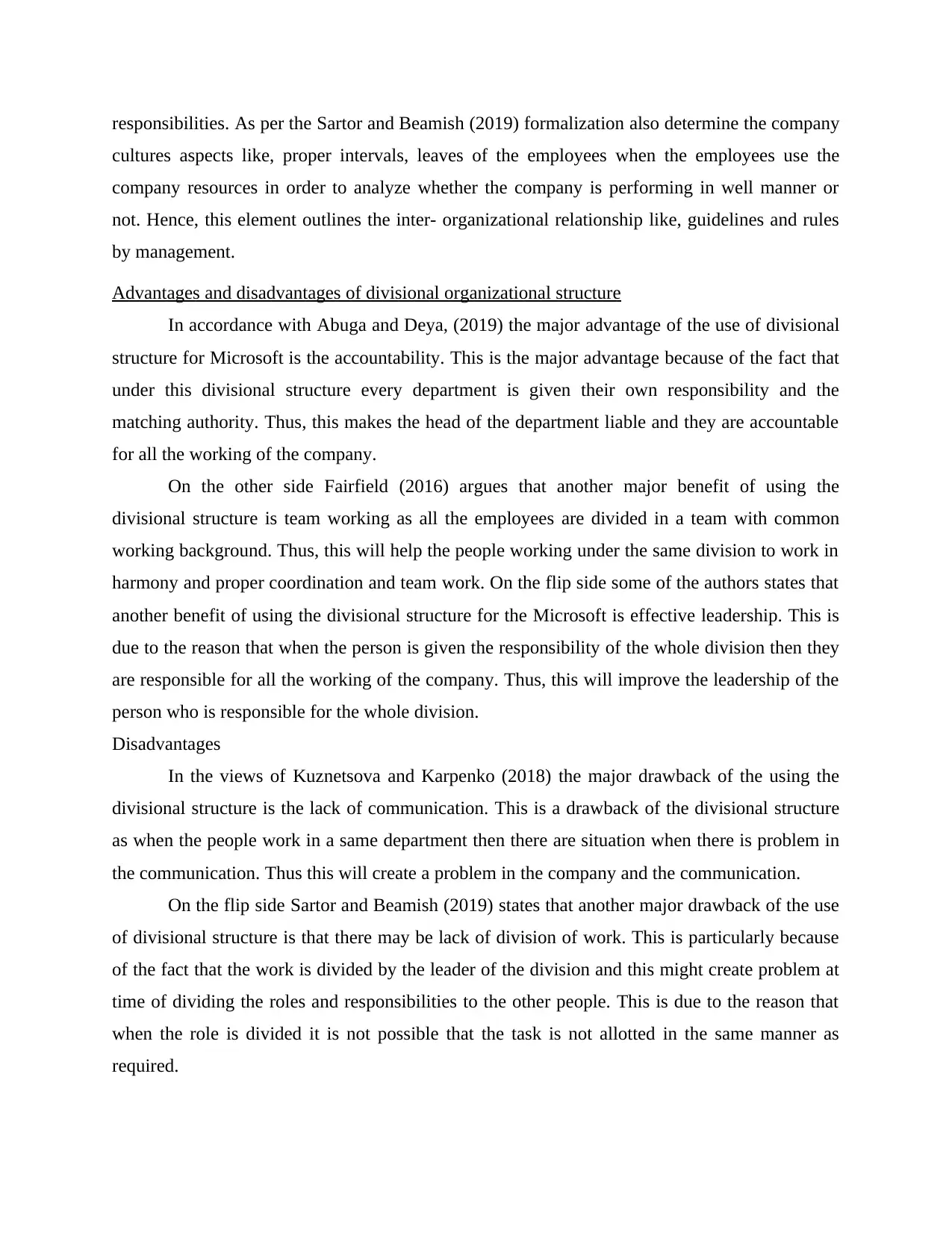
responsibilities. As per the Sartor and Beamish (2019) formalization also determine the company
cultures aspects like, proper intervals, leaves of the employees when the employees use the
company resources in order to analyze whether the company is performing in well manner or
not. Hence, this element outlines the inter- organizational relationship like, guidelines and rules
by management.
Advantages and disadvantages of divisional organizational structure
In accordance with Abuga and Deya, (2019) the major advantage of the use of divisional
structure for Microsoft is the accountability. This is the major advantage because of the fact that
under this divisional structure every department is given their own responsibility and the
matching authority. Thus, this makes the head of the department liable and they are accountable
for all the working of the company.
On the other side Fairfield (2016) argues that another major benefit of using the
divisional structure is team working as all the employees are divided in a team with common
working background. Thus, this will help the people working under the same division to work in
harmony and proper coordination and team work. On the flip side some of the authors states that
another benefit of using the divisional structure for the Microsoft is effective leadership. This is
due to the reason that when the person is given the responsibility of the whole division then they
are responsible for all the working of the company. Thus, this will improve the leadership of the
person who is responsible for the whole division.
Disadvantages
In the views of Kuznetsova and Karpenko (2018) the major drawback of the using the
divisional structure is the lack of communication. This is a drawback of the divisional structure
as when the people work in a same department then there are situation when there is problem in
the communication. Thus this will create a problem in the company and the communication.
On the flip side Sartor and Beamish (2019) states that another major drawback of the use
of divisional structure is that there may be lack of division of work. This is particularly because
of the fact that the work is divided by the leader of the division and this might create problem at
time of dividing the roles and responsibilities to the other people. This is due to the reason that
when the role is divided it is not possible that the task is not allotted in the same manner as
required.
cultures aspects like, proper intervals, leaves of the employees when the employees use the
company resources in order to analyze whether the company is performing in well manner or
not. Hence, this element outlines the inter- organizational relationship like, guidelines and rules
by management.
Advantages and disadvantages of divisional organizational structure
In accordance with Abuga and Deya, (2019) the major advantage of the use of divisional
structure for Microsoft is the accountability. This is the major advantage because of the fact that
under this divisional structure every department is given their own responsibility and the
matching authority. Thus, this makes the head of the department liable and they are accountable
for all the working of the company.
On the other side Fairfield (2016) argues that another major benefit of using the
divisional structure is team working as all the employees are divided in a team with common
working background. Thus, this will help the people working under the same division to work in
harmony and proper coordination and team work. On the flip side some of the authors states that
another benefit of using the divisional structure for the Microsoft is effective leadership. This is
due to the reason that when the person is given the responsibility of the whole division then they
are responsible for all the working of the company. Thus, this will improve the leadership of the
person who is responsible for the whole division.
Disadvantages
In the views of Kuznetsova and Karpenko (2018) the major drawback of the using the
divisional structure is the lack of communication. This is a drawback of the divisional structure
as when the people work in a same department then there are situation when there is problem in
the communication. Thus this will create a problem in the company and the communication.
On the flip side Sartor and Beamish (2019) states that another major drawback of the use
of divisional structure is that there may be lack of division of work. This is particularly because
of the fact that the work is divided by the leader of the division and this might create problem at
time of dividing the roles and responsibilities to the other people. This is due to the reason that
when the role is divided it is not possible that the task is not allotted in the same manner as
required.
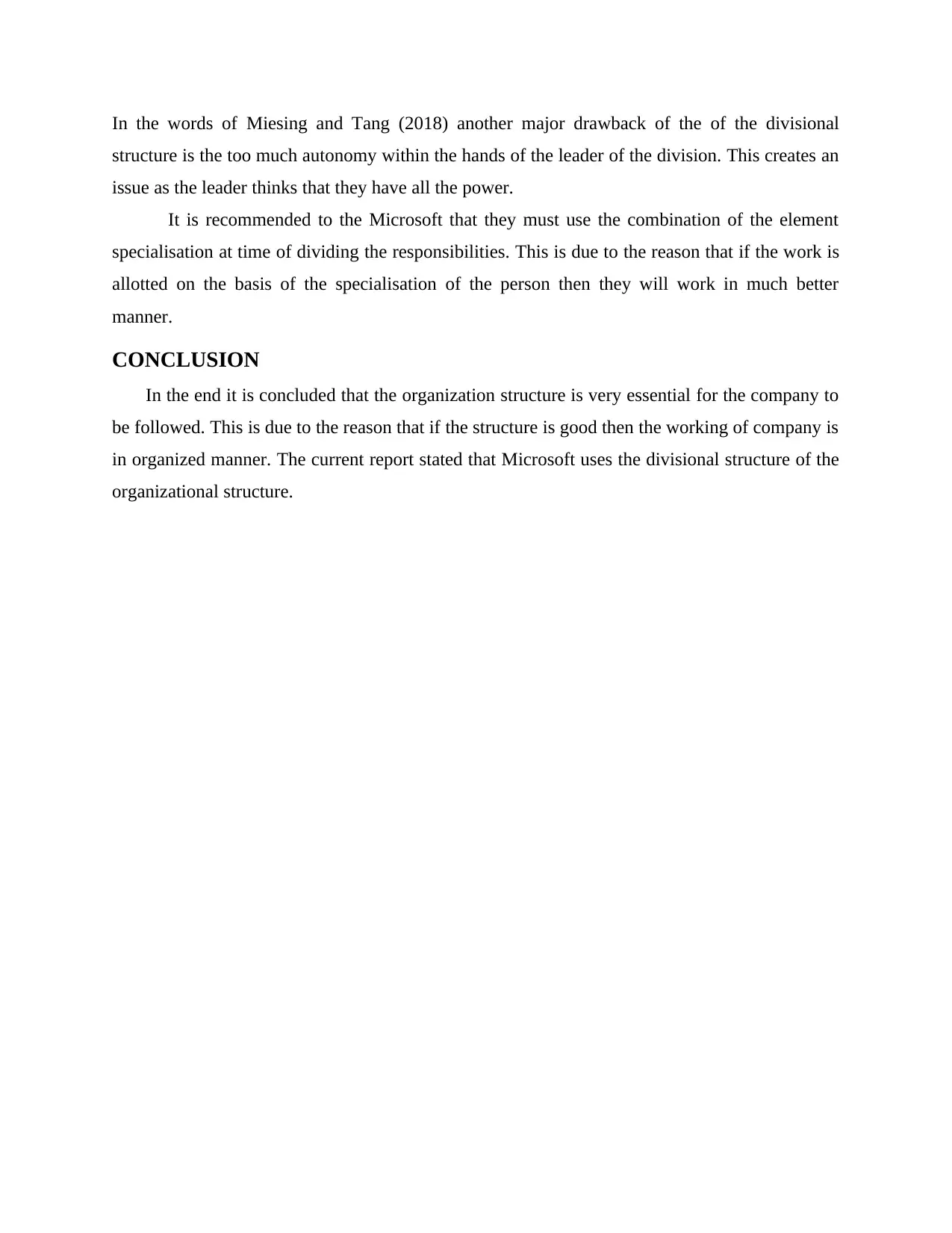
In the words of Miesing and Tang (2018) another major drawback of the of the divisional
structure is the too much autonomy within the hands of the leader of the division. This creates an
issue as the leader thinks that they have all the power.
It is recommended to the Microsoft that they must use the combination of the element
specialisation at time of dividing the responsibilities. This is due to the reason that if the work is
allotted on the basis of the specialisation of the person then they will work in much better
manner.
CONCLUSION
In the end it is concluded that the organization structure is very essential for the company to
be followed. This is due to the reason that if the structure is good then the working of company is
in organized manner. The current report stated that Microsoft uses the divisional structure of the
organizational structure.
structure is the too much autonomy within the hands of the leader of the division. This creates an
issue as the leader thinks that they have all the power.
It is recommended to the Microsoft that they must use the combination of the element
specialisation at time of dividing the responsibilities. This is due to the reason that if the work is
allotted on the basis of the specialisation of the person then they will work in much better
manner.
CONCLUSION
In the end it is concluded that the organization structure is very essential for the company to
be followed. This is due to the reason that if the structure is good then the working of company is
in organized manner. The current report stated that Microsoft uses the divisional structure of the
organizational structure.
⊘ This is a preview!⊘
Do you want full access?
Subscribe today to unlock all pages.

Trusted by 1+ million students worldwide

REFERENCES
Books and Journals
Abuga, R. M. and Deya, J., 2019. Effect of organizational structure on strategy implementation:
A case study of Safaricom Kenya Ltd. International Academic Journal of Human
Resource and Business Administration. 3(5). pp.247-254.
Bonacchi, M., Marra, A. and Zarowin, P., 2019. Organizational structure and earnings quality of
private and public firms. Review of Accounting Studies. 24(3). pp.1066-1113.
Fairfield, K. D., 2016. Understanding functional and divisional organizational structure: A
classroom exercise. Management Teaching Review. 1(4). pp.242-251.
Galván, I. P. and Galván, I. P., 2019. The Background of Organizational Structures', Designing
Local e-Government: The Pillars of Organizational Structure (pp. 5-52). Emerald
Publishing Limited.
Kaufmann, W., Borry, E. L. and DeHart‐Davis, L., 2019. More than pathological formalization:
Understanding organizational structure and red tape. Public Administration
Review. 79(2). pp.236-245.
Kuznetsova, I. and Karpenko, Y., 2018. The technology of budgeting enterprises with the
divisional structure. Innovative Technologies and Scientific Solutions for Industries. (1
(3)). pp.96-102.
Miesing, P. and Tang, M., 2018. Technology transfer institutions in China: A comparison of
value chain and organizational structure perspectives. Technology Transfer Mechanisms
in China: A Comparative Study from Value Chain and Organizational Structure
Perspectives. Singapore: World Scientific Publishing Co. Pte. Ltd. pp.43-60.
Sartor, M. A. and Beamish, P. W., 2019. Private sector corruption, public sector corruption and
the organizational structure of foreign subsidiaries. Journal of Business Ethics. pp.1-20.
Books and Journals
Abuga, R. M. and Deya, J., 2019. Effect of organizational structure on strategy implementation:
A case study of Safaricom Kenya Ltd. International Academic Journal of Human
Resource and Business Administration. 3(5). pp.247-254.
Bonacchi, M., Marra, A. and Zarowin, P., 2019. Organizational structure and earnings quality of
private and public firms. Review of Accounting Studies. 24(3). pp.1066-1113.
Fairfield, K. D., 2016. Understanding functional and divisional organizational structure: A
classroom exercise. Management Teaching Review. 1(4). pp.242-251.
Galván, I. P. and Galván, I. P., 2019. The Background of Organizational Structures', Designing
Local e-Government: The Pillars of Organizational Structure (pp. 5-52). Emerald
Publishing Limited.
Kaufmann, W., Borry, E. L. and DeHart‐Davis, L., 2019. More than pathological formalization:
Understanding organizational structure and red tape. Public Administration
Review. 79(2). pp.236-245.
Kuznetsova, I. and Karpenko, Y., 2018. The technology of budgeting enterprises with the
divisional structure. Innovative Technologies and Scientific Solutions for Industries. (1
(3)). pp.96-102.
Miesing, P. and Tang, M., 2018. Technology transfer institutions in China: A comparison of
value chain and organizational structure perspectives. Technology Transfer Mechanisms
in China: A Comparative Study from Value Chain and Organizational Structure
Perspectives. Singapore: World Scientific Publishing Co. Pte. Ltd. pp.43-60.
Sartor, M. A. and Beamish, P. W., 2019. Private sector corruption, public sector corruption and
the organizational structure of foreign subsidiaries. Journal of Business Ethics. pp.1-20.
1 out of 7
Related Documents
Your All-in-One AI-Powered Toolkit for Academic Success.
+13062052269
info@desklib.com
Available 24*7 on WhatsApp / Email
![[object Object]](/_next/static/media/star-bottom.7253800d.svg)
Unlock your academic potential
Copyright © 2020–2025 A2Z Services. All Rights Reserved. Developed and managed by ZUCOL.





